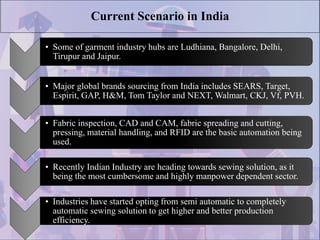Sewbot clothing manufacturing
- 1. Sew-Bot And The Clothing Manufacturing Industry Submitted by : Arpita Tripathy Tulasi Kumar Nanda
- 2. Why Industry need robots? Eliminate a human operator. Human is bad for the product (Ex: semiconductor handling.) To save labor and reduce cost Product is bad for the human ( Ex: radioactive product.) Replace human operators where there is danger. Maintain Quality Working with harmful matter. Working with dangerous machinery Avoid repetitive strain syndrome
- 3. 4th century BC- Archytas -"The Pigeon“. 2017- Kengoro-the University of Tokyo. 2015-SOPHIA 2000-ASIMO 1990s- The Cyberknife 1980s- Takeo Kanade. 1970s- WABOT The word “robotics” was first coined by Issac Asimov in the year 1941-1942. 1136–1206- Al- Jazari 1088- Su Song 1023–957 BC- Yan Shi 10–70 AD Hero of Alexandria 250 BC-Clepsydra Arrival of robots
- 4. What is automation? Automation is the process or technique of doing certain works by the use of automatic equipment in the place of human operators during a product manufacturing. Achieved by the use of highly automatic tools and equipment embedded with sophisticated electronic devices. Widely used in several areas such as manufacturing industries, medicine, healthcare, engineering, supply chain, and distribution. Apparel manufacturing- labour intensive-automated processes- digital components, and artificial intelligence(AI).
- 5. No progress in the clothing industry as compared to automobile production. Availability of low cost labour in many developing countries. High initial investment on the automatic tools and equipment. Complexities involved in the automation. Production of a garment style in different sizes with change in specification. Frequent style changes. Factors that prohibit automatic equipments to be used:
- 6. What are sewbots? Sewbots are actually robots that are installed in the apparel industry with enhanced robotic and machine technology. For example, LOWRY from SoftWear Automation, industrial robots by Sewbo. Inc, Maica automated lines and Automated machines by Atlanta Attachment Company.
- 7. DIFFERENT PURPOSE OF MACHINE & HOW IT DIFFERS FROM SEWBOT
- 8. Purpose And Operation Of Equipment Manually operated General purpose machines-It requires the operator to control both the machine and material. Example –SNLS m/c Semi automatic special purpose machines-The operator places the material or garment part ,activates the machine and then the machine completes the cycle. Example- JUKI AP-874S Jeans pocket setter(semiautomatic) Automatic Special purpose machines-In fully automated operation the machine performs the entire process. Example-automatic button sewer or attach Robotized machine-Electronic controls give machines the capability of handling both information and materials.Example-Sewbo Source : Apparel manufacturing Ruth E Glock
- 9. Maica automated machine button holes and button attach for cuff in shirts Atlanta Attachment company automatic collar, cuff and waistband workstation machine and cuff machine to cut collar, cuff & waistband as per size PFAFF 3538 Pocket loader for pocket hem specially for denims Source : Atlanta attachment co., Maica Italia
- 10. Atlanta attachment company automatic circular cuff machine to prepare cuff for sweatshirts HS-600AAutomatic shoulder strap m/c to prepare strap
- 11. Sewbo complete automated robot for basic t-shirt preparation. Sewbot complete automated line for basic t-shirt preparation.
- 13. Garment manufacturing process without Sewbot vs. Sewbot Garment Manufacturing process For example if for making a basic round crew neck we require Following operations- 1. Set parts & Shoulder attach 2. Neckband preparation 3. Neckband attach 4. Shoulder to shoulder tape attach 5. Neckband t/s 6. Sleeve attach 7. Side seam attach 8. Sleeve hem 9. Bottom hem 10. Wash care label attach 11. Main label attach No of operator required- 11 Time required for each operation will vary as per operator cycle time Directly affecting the efficiency In case of Sewbot Manufacturing process 1 robot doing all the process Pick and dispose by robot and not by humans which differentiate it from automated machines More production Standard time maintained for every operation More output high efficiency
- 15. Advantages & Disadvantages Of Garment Manufacturing process without Sewbot A D V A N T A G E S D I S A D V A N T A G E S Advantages No extra cost for the initial setups. Small space is required for each operator. Instant solution for the technical problem Operator can handle all kind of fabrics Disadvantages Absenteeism does cause many problems. Even a minor product change cannot be accommodated Quality problems easily accumulate. Machine breakdown can be critical and troublesome. Pre-production planning skill is essential. The line is paced by the slowest operation
- 16. Advantages Increase in productivity Increased inventory turnover Consistent in quality Replacement of repetitive and monotonous work Reduction of variability among products and product batches Performing jobs beyond human capability Reduction of direct human labor costs and overheads Disadvantages High initial cost of installation Technical problems High cost of maintenance Limited scope Lack of flexibility Create Unemployment D I S A D V A N T A G E S A D V A N T A G E S Advantages &Disadvantages Of Sewbot Manufacturing Process
- 17. SEWBOTS AND AUTOMATIC SEWING MANUFACTURING COMPANIES
- 19. About Softwear Automation • Automated sewing machine from soft wear automation known as LOWRY. • Part of the company’s initiative to automate the textile industry in the same way that other industries have used robotics for manufacturing • Their sewbot family includes the Lowry, Budger, And Asm sewbots • Their sewbot worklines allow manufacturers to sew local, geographically shortening the distance between manufacturing and consumers. • T.EVO: sewbots step into shoe manufacturing
- 20. About Sewbo Automation • Sewbo is a start up by Jonathan Zornow wants to automate the garment construction process as well. • Using a stiffener for rigidity, removed by hot water at the end of the production • Not available commercially
- 21. About Shima Seiki – 3D Knitting Technology • The Shima- Seiki a Japan based knitting industry has developed a 3-D knitting technology • SHIMA SEIKI’s revolutionary WHOLEGARMENT knitwear is produced in one entire piece, three-dimensionally, directly on the knitting machine. Consequently it requires no expensive, time- consuming post-production labor.
- 22. The Level Of Adoption Of Automation Or Sew Bot Depends On… Industry size Export market Garment styles Profitability Available Budgets Management Policy Technical Skills Competitive Advantage
- 23. Current Scenario of India The clothing industry is being transformed from a traditional, labor- intensive industry, into a highly automated and computer-aided industry. To fulfil the high-quality requirements, companies have started using automation but the transition is slow. Indian industries use automation to meet the challenges posed by the pluralistic market.
- 24. Current Scenario in India • Some of garment industry hubs are Ludhiana, Bangalore, Delhi, Tirupur and Jaipur. • Major global brands sourcing from India includes SEARS, Target, Espirit, GAP, H&M, Tom Taylor and NEXT, Walmart, CKJ, Vf, PVH. • Fabric inspection, CAD and CAM, fabric spreading and cutting, pressing, material handling, and RFID are the basic automation being used. • Recently Indian Industry are heading towards sewing solution, as it being the most cumbersome and highly manpower dependent sector. • Industries have started opting from semi automatic to completely automatic sewing solution to get higher and better production efficiency.
- 25. The Factory Automation in India has witnessed a really steep growth in past 5–7 years. But an increase use impacts the prospects of the country's labour force. Automation is a costly affair and is majorly opted by large-scale industries. Current Scenario in India
- 26. SWOT Analysis Strengths • Efficiency and productivity • Saves time • Products at a lower costs • Reduction in labor costs • No idle time • Reduced lead time Weaknesses • High capital expenditure • Complex procedures • Technical challenges • Higher level of maintenance • Human error can cause dysfunction
- 27. SWOT Analysis Opportunities • Tapping the untapped markets • Better management and sales • Creation of major market leaders • Higher competitiveness • Continuous production • Safer environment Threats • Loss of employment • Disruption of lives • Impact in developing geographies • Upgrading or reskilling for new roles
- 28. . WORLD PERSPECTIVE ON SEWBOT
- 29. Major Countries Exporting Garment • CHINA • INDIA • BANGLADESH • VIETNAM • WESTERN EUROPE • INDONESIA • TURKEY • SRI LANKA Source : https://shenglufashion.com/2017/10/12/wto-reports-world-textile-and- apparel-trade-in-2016/
- 30. Machines being used in the Industry
- 31. INVESTMENT INTO TECHNOLOGY Low manufacturing price Large Quantity in Less Time Evenness in Quality Lower Carbon Footprint Flexibility Criteria For Sustaining In The Industry
- 32. INDIA Raymond Loyal Group Mandhana Industries Alok Industries Arvind Mill SOURCE: • https://www.bizvibe.com/blog/top-garment-manufacturers-in-india/ • http://www.chinadaily.com.cn/business/2014-10/28/content_18811642_5.htm • http://vtown.vn/en/category10/genre901.html CHINA Tianyuan Garments Company Guangzhou Jidian Fashion Co. Ltd Guangzhou Junyu Clothing Co., Ltd Guangzhou Jiazhuo Garment Manufacturing Factory Hengxing Clothing Factory BANGLADESH Ha-meem Group BEXIMCO Fashions Ltd. Square Fashions Ltd. Opex Sinha Group. DBL Group. VIETNAM Ha Noi Textile and Garment Joint- stock Corporation Nam Dinh Textile and Garment Joint- stock Corporation Phong Phu International VINATEX Viet Tien Garment Joint-stock Corporation Top Industries Investing In Technology
- 33. Shift of Apparel manufacturing unit to developed nation. Less man and more machine Unbeatable cost of production 71% rise in production FACTS FROM CASE: Sew-Bot Is Revolutionizing the Clothing Manufacturing Industry SOURCE: https://thetechnoskeptic.com/sewbots/
- 34. SEWBOTS- “A BOON OR BANE”
- 35. LAY OFFS DISAPPEARANCE OF SMALL INDUSTRIES EXPLOITATION OF LABOUR FORCE LESS COMPETITORS Result Of Sewbot
- 36. INCREASE SKILLS INCREASE IN KNOWLEDGE / EDUCATION FOCUS ON ENTREPRENEURSHIP FOCUS ON CREATIVE WORK How To Cope With Sewbots
- 37. Machines are technical robots that can do only what it has been asked to do. It doesn’t have a creative mind to judge and create something new. In the Fashion Industry, creativity and quality comes first before quantity. A robot might hamper the quality of a garment and it would be discarded but if a human hampers the quality, he/she can redo the only part that is hampered. CURRENT TRENDS AND SEWBOTS
- 38. CONCLUSION • For the past 30 years, technology has rapidly evolved in every area save sewing. • Advanced computer-assisted design software has made the design process easier. • Computer controlled cutting has reduced bottlenecks in the cutting room. • Yet, the only real solution around sewing has been to chase cheap labor around the globe. • Sew Bot is disrupting the $100 billion sewn products industry by creating autonomous sewn machines for Home Goods, Footwear & Apparel. • It will be a very long time, if ever, before things are 100% automated.
- 39. But Sew Bots are able to leverage machines to achieve incredible productivity to the point where the labor cost to manufacture a yard of fabric is minimized Understandably, the rise of automated sewing has raised concerns that it could displace countless low-wage garment workers in the coming decade.
- 40. References • https://www.sciencedirect.com/science/article/pii/B978008101211600001X • http://www.deviceplus.com/connect/sewbot-in-the-clothing-manufacturing-industry/ • http://www.catchnews.com/business-economy-news/robots-vs-people-automation-set-to-hit-jobs-in-india-s- textile-industry-1467996260.html • https://www.quora.com/What-is-the-future-of-automation-in-India • https://www.jagranjosh.com/current-affairs/impact-of-automation-on-employment-opportunities-analysis- 1507117867-1 • https://www.sciencedirect.com/science/article/pii/B978008101211600001X • http://sci-hub.hk/http://linkinghub.elsevier.com/retrieve/pii/B978008101211600001X • http://softwearautomation.com/about/ • http://www.deviceplus.com/connect/sewbot-in-the-clothing-manufacturing-industry/ • http://strobotics.com/whyrobot.htm • https://en.wikipedia.org/wiki/History_of_robots








































